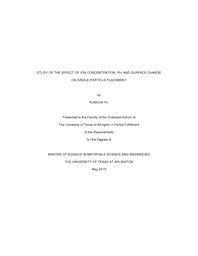
ATTENTION: The works hosted here are being migrated to a new repository that will consolidate resources, improve discoverability, and better show UTA's research impact on the global community. We will update authors as the migration progresses. Please see MavMatrix for more information.
Show simple item record
| dc.contributor.author | Yu, Kunhua | en_US |
| dc.date.accessioned | 2015-07-31T22:10:05Z | |
| dc.date.available | 2015-07-31T22:10:05Z | |
| dc.date.issued | 2015 | |
| dc.date.submitted | January 2015 | en_US |
| dc.identifier.other | DISS-13062 | en_US |
| dc.identifier.uri | http://hdl.handle.net/10106/25032 | |
| dc.description.abstract | Supervising Professor: Seong Jin Koh Single particle placement (SPP) in which nanoparticles are placed on exact substrate positions on a single particle level has drawn a lot of attention as it can be used as an effective tool for bottom-up fabrications of nanoscale systems. In SPP, single nanoparticles are electrically guided toward substrate target positions through electrostatic funneling mechanism and once a single nanoparticle is placed on a target position it prevents the other nanoparticles from approaching toward the substrate, leading to placement of exactly one nanoparticle on each target position. This thesis investigates the role of three key parameters on the effectiveness of the SPP. The three parameters are the surface charge of the nanoparticles, ion concentration of the colloidal solution, and the pH of the colloidal solution. These three parameters control the electrostatic interactions between the nanoparticles and the substrate, thereby enabling fine tuning the SPP process. The SPP was carried out using 30 nm colloidal Au nanoparticles as the model nanoparticles. The electrostatic guiding structure was formed using self-assembled monolayers (SAMs) of 3-aminopropyltriethoxysilane (APTES) and 16-mercaptohexadecanoic acid (MHA) formed on silicon dioxide and Au substrate surfaces, respectively. Circular patterns of APTES-terminated SiO2 were formed on silicon substrate with remaining area covered with MHA-terminated Au surface, with APTES-terminated circular SiO2 positively charged and MHA-terminated Au surface negatively charged. The electrostatic interaction of negatively-charged Au nanoparticles and the SAMs-modified patterned substrate was investigated with differing diameters of the circular templates under varying conditions of the three key parameters.The surface charge of the nanoparticle was controlled by attaching DNA molecules to the Au nanoparticles surface. Gold nanoparticle surfaces were loaded with thiol-terminated (H-S-) single-stranded DNA through Au-S chemical bonding. The ion concentration and buffer pH of the colloidal solution were controlled by varying Na2HPO4 and NaH2PO4 concentrations in DI water. The ion concentrations were varied from 0.01 mM to 0.1 mM with pH fixed at 7.0. pH’s were varied from 7.0 to 8.0 with the ion concentration fixed at 0.05 mM. The effects of the three parameters on the SPP were investigated using varying circular template diameters, ranging from 150 nm to 300 nm. The electrostatic interactions between nanoparticles and the substrate guiding structure prevented single nanoparticles from being placed onto small circular templates and there existed critical diameters below which no particles can enter the circular templates. The SPP occurred at these critical diameters; for smaller diameters, no nanoparticles enter the circular templates and for larger diameters, more than one nanoparticle enter the circular template. The change of critical diameters with change of the three parameters was investigated. When no DNA is loaded on the nanoparticle surface, the Au nanoparticles became aggregated at ion concentration of 0.01 mM, the lowest ion concentration studied in this thesis. With nanoparticles loaded with DNA, the nanoparticle surface charge increased, resulting in zeta potential of -35 mV, which enabled the SPP. For ion concentrations of 0.1 mM, 0.05 mM and 0.01 mM with pH fixed at 7.0, the SPP was enabled with critical diameters of 210 nm, 250 nm and 280 nm, respectively. The increasing critical diameters with decreasing ion concentrations were attributed to longer ranges of electrostatic interactions between the nanoparticles and substrate surface with increased Debye lengths. For pH of 7.0, 7.5 and 8.0 with the ion concentration fixed at 0.05 mM, the critical diameters were measured as 250 nm, 280 nm and 320 nm, respectively. This was attributed to increasing degree of deprotonation of the carboxyl-terminated MHA SAMs (COO) on the patterned Au substrate with increasing pH, leading to more repulsive forces between the nanoparticles and Au patterns. This study showed that the SPP process can be tuned with appropriate combinations of nanoparticle surface charge, ion concentrations of the nanoparticle colloid and the pH of the nanoparticle colloid. | en_US |
| dc.description.sponsorship | Koh, Seong Jin | en_US |
| dc.language.iso | en | en_US |
| dc.publisher | Materials Science & Engineering | en_US |
| dc.title | Study Of The Effect Of Ion Concentration, pH, And Surface Charge On Single-particle Placement | en_US |
| dc.type | M.S. | en_US |
| dc.contributor.committeeChair | Koh, Seong Jin | en_US |
| dc.degree.department | Materials Science & Engineering | en_US |
| dc.degree.discipline | Materials Science & Engineering | en_US |
| dc.degree.grantor | University of Texas at Arlington | en_US |
| dc.degree.level | masters | en_US |
| dc.degree.name | M.S. | en_US |
Files in this item
- Name:
- YU_uta_2502M_13062.pdf
- Size:
- 2.397Mb
- Format:
- PDF
This item appears in the following Collection(s)
Show simple item record


